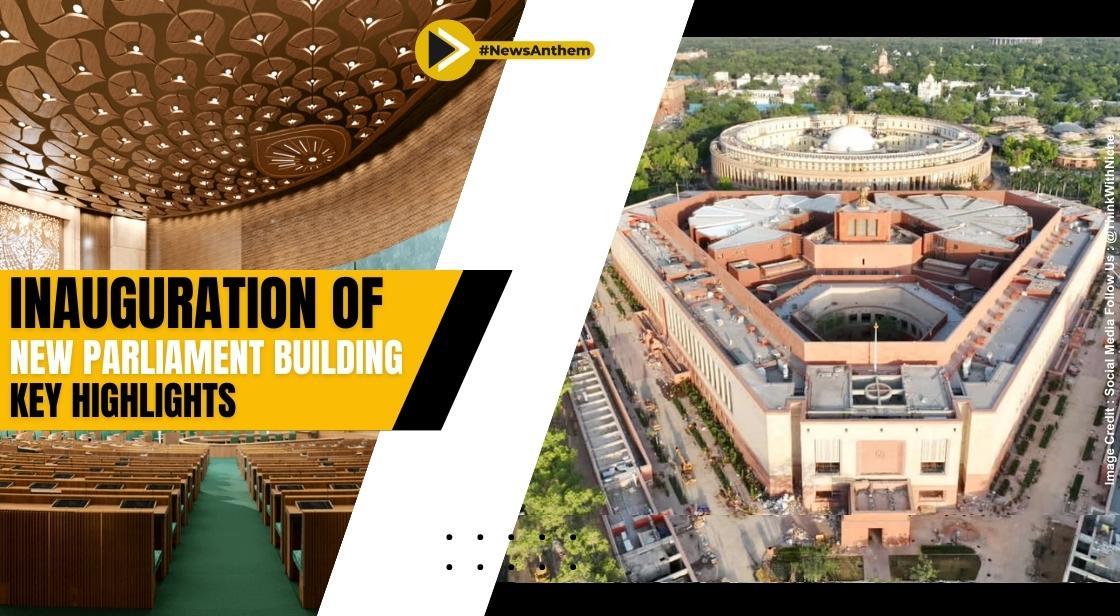Inauguration of New Parliament Building: Key Highlights

News Synopsis
Prime Minister Narendra Modi Inaugurates New Parliament Building
Prime Minister Narendra Modi marked a significant moment as he inaugurated the new Parliament building on Sunday.
Here are the key highlights from the event, as it unfolded from 7 am onwards.
Religious Ceremonies and Rituals
Dressed in a traditional dhoti and kurta, Prime Minister Narendra Modi entered the Parliament premises to commence the inauguration ceremonies. Vedic hymns filled the air as the Prime Minister performed Ganapati Homam as part of the Vastu Pooja rituals.
During the proceedings, he reverently paid his respects to the 'Sengol,' a ceremonial sceptre with roots tracing back to the Chola dynasty. The 'Sengol' was consecrated by high priests from 21 'adheenams' in Tamil Nadu and subsequently handed over to the Prime Minister.
Boycott by Opposition Parties
While the occasion was significant, it faced a partial boycott from at least 20 opposition parties who contended that the head of state, President Droupadi Murmu, should have been the one to inaugurate the new Parliament building.
All-Religion Prayers and Sacred Hymns
In addition to the Vedic hymns, prayers representing various religions were held to mark the inauguration of the new parliament building. The spiritual strains of Shaivite hymns from the sacred Thevaram text created an ambiance befitting the ceremonial rituals.
Efficient Construction Timeline
Unlike the previous Parliament building, which took six years to complete, the new structure was ready in an impressive record time of just two and a half years. Spanning across a built-up area of 64,500 square meters, the new building showcases efficient project execution.
Chambers and Committee Rooms
The Lok Sabha Chamber within the new building boasts 888 seats, providing accommodation for 1,272 members during joint sittings with the Rajya Sabha. The Upper House chamber, on the other hand, features 384 seats. Furthermore, the new building includes six additional committee rooms and 92 office spaces for the Council of Ministers.
Exhibition Galleries and Artwork
The public entrances to the new Parliament building lead to three galleries: the Sangeet Gallery, which exhibits dance, song, and musical traditions of India; the Sthapthya Gallery, showcasing the architectural heritage of the country; and the Shilp Gallery, highlighting distinct handicraft traditions from various states. The building is adorned with approximately 5,000 pieces of artwork, including paintings, wall panels, stone sculptures, and metal murals.
Exquisite Interior Decor
The Lok Sabha chamber features a peacock motif in its interior decoration, including carpets, ceilings, and lattice work for windows. In contrast, the Rajya Sabha chamber is embellished with lotus motifs, lending it a unique aesthetic appeal.
Distinguished Attendees
While the formal inauguration function witnessed the presence of Andhra Pradesh Chief Minister Y S Jagan Mohan Reddy as the sole non-NDA leader, several Chief Ministers from NDA constituent parties, such as Maharashtra's Eknath Shinde, Meghalaya's Conrad Sangma, Mizoram's Zoramthanga, Nagaland's Neiphu Rio, and Sikkim's Prem Singh Tamang, were also in attendance. Additionally, ambassadors from various foreign countries graced the occasion with their presence.
Commemorative Stamp and Coin
As part of the inauguration, the Prime Minister released a commemorative postal stamp and a Rs 75 coin to commemorate the significance of the event.
Message of Progress
In his address, the Prime Minister emphasized the enduring concept of "Swaraj" advocated by Mahatma Gandhi, which symbolizes self-governance and self-reliance. He drew attention to the fact that 25 years before India gained independence, Mahatma Gandhi had captured the hearts and minds of the nation through the non-cooperation movement, inspiring a collective desire for freedom.
Looking ahead, the Prime Minister envisioned a future where India would celebrate 100 years of independence in the next 25 years. He urged every citizen to actively contribute towards the development and progress of the nation during this transformative period, which he referred to as "Azadi ka Amrit Kaal" or the era of the nectar of independence.
The Prime Minister's message resonated with the spirit of unity, resilience, and progress that defines the nation's journey. He called upon the people of India to work together, transcending differences, to build a prosperous and inclusive India. He stressed the importance of leveraging the country's potential in various sectors to drive growth, innovation, and sustainable development.
Furthermore, the Prime Minister expressed his vision for India to become a global leader in technology, innovation, and economic prowess. He highlighted the need for advanced infrastructure and modern facilities, such as the new Parliament building, to support the aspirations and aspirations of the nation.
The inauguration of the new Parliament building stood as a testament to India's commitment to progress and the democratic values it upholds. It symbolized the nation's collective determination to build a better future, where governance, legislation, and policymaking take place in a state-of-the-art facility that embodies the ideals of transparency, accountability, and efficiency.
As the Prime Minister concluded his speech, he reiterated his faith in the spirit and capabilities of the Indian people. He called upon citizens to unite, overcome challenges, and strive towards realizing the full potential of India's journey towards progress, prosperity, and self-reliance.
In essence, the Prime Minister's message reflected a vision of a strong and united India, driven by the principles of self-governance, innovation, and inclusive growth. It resonated with the aspirations of the nation and inspired citizens to actively contribute to the ongoing journey of nation-building and transformation.
ThinkWithNiche News' conclusion
The inauguration of the new Parliament building marked a significant milestone in India's journey towards progress and development. The event showcased the nation's commitment to democracy, transparency, and efficient governance.
The Prime Minister's address, with its emphasis on Mahatma Gandhi's ideals of Swaraj and the vision for India's future, ignited a sense of collective responsibility among the citizens. It emphasized the need for unity, resilience, and active participation in shaping a prosperous and inclusive India.
The new Parliament building stands as a symbol of India's aspirations and determination to excel on the global stage. It is not just a physical structure but a representation of India's growth, innovation, and potential in various sectors.
The Prime Minister's message encouraged citizens to leverage their talents, work towards self-reliance, and contribute to the nation's development during the transformative "Azadi ka Amrit Kaal."
As India moves forward, the nation's progress relies on the concerted efforts of its people, the strength of its democracy, and its commitment to inclusive development. The message of progress delivered during the inauguration of the new Parliament building serves as a reminder of the shared responsibility to build a strong, prosperous, and united India. By embracing the principles of Swaraj and working towards a developed nation, India can fulfill its potential and create a brighter future for all its citizens.
You May Like









